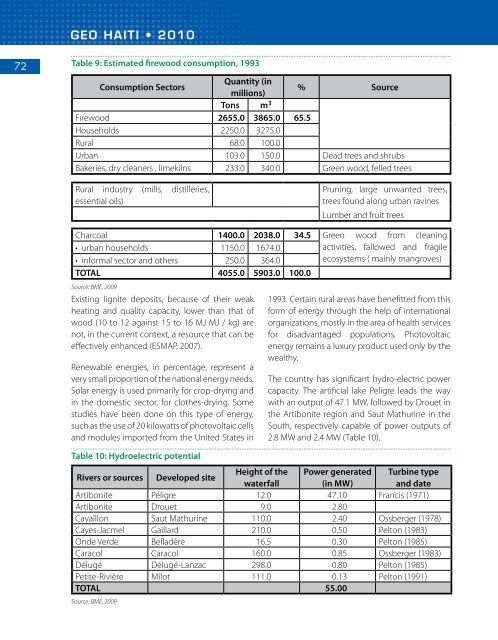GEO Haiti 2010
GEO Haiti 2010
GEO Haiti 2010
You also want an ePaper? Increase the reach of your titles
YUMPU automatically turns print PDFs into web optimized ePapers that Google loves.
<strong>GEO</strong> HAITI • <strong>2010</strong><br />
72<br />
Table 9: Estimated firewood consumption, 1993<br />
Consumption Sectors<br />
Quantity (in<br />
millions)<br />
% Source<br />
Tons m 3<br />
Firewood 2655.0 3865.0 65.5<br />
Households 2250.0 3275.0<br />
Rural 68.0 100.0<br />
Urban 103.0 150.0 Dead trees and shrubs<br />
Bakeries, dry cleaners , limekilns 233.0 340.0 Green wood, felled trees<br />
Rural industry (mills, distilleries,<br />
essential oils)<br />
Pruning, large unwanted trees,<br />
trees found along urban ravines<br />
Lumber and fruit trees<br />
Charcoal 1400.0 2038.0 34.5 Green wood from cleaning<br />
• urban households 1150.0 1674.0<br />
activities, fallowed and fragile<br />
• informal sector and others 250.0 364.0<br />
ecosystems ( mainly mangroves)<br />
TOTAL 4055.0 5903.0 100.0<br />
Source: BME, 2009<br />
Existing lignite deposits, because of their weak<br />
heating and quality capacity, lower than that of<br />
wood (10 to 12 against 15 to 16 MJ MJ / kg) are<br />
not, in the current context, a resource that can be<br />
effectively enhanced (ESMAP, 2007).<br />
Renewable energies, in percentage, represent a<br />
very small proportion of the national energy needs.<br />
Solar energy is used primarily for crop-drying and<br />
in the domestic sector, for clothes-drying. Some<br />
studies have been done on this type of energy,<br />
such as the use of 20 kilowatts of photovoltaic cells<br />
and modules imported from the United States in<br />
Table 10: Hydroelectric potential<br />
1993. Certain rural areas have benefitted from this<br />
form of energy through the help of international<br />
organizations, mostly in the area of health services<br />
for disadvantaged populations. Photovoltaic<br />
energy remains a luxury product used only by the<br />
wealthy.<br />
The country has significant hydro-electric power<br />
capacity. The artificial lake Peligre leads the way<br />
with an output of 47.1 MW, followed by Drouet in<br />
the Artibonite region and Saut Mathurine in the<br />
South, respectively capable of power outputs of<br />
2.8 MW and 2.4 MW (Table 10).<br />
Rivers or sources Developed site<br />
Height of the Power generated Turbine type<br />
waterfall<br />
(in MW)<br />
and date<br />
Artibonite Péligre 12.0 47.10 Francis (1971)<br />
Artibonite Drouet 9.0 2.80<br />
Cavaillon Saut Mathurine 110.0 2.40 Ossberger (1978)<br />
Cayes-Jacmel Gaillard 210.0 0.50 Pelton (1983)<br />
Onde Verde Belladère 16.5 0.30 Pelton (1985)<br />
Caracol Caracol 160.0 0.85 Ossberger (1983)<br />
Délugé Délugé-Lanzac 298.0 0.80 Pelton (1985)<br />
Petite-Rivière Milot 111.0 0.13 Pelton (1991)<br />
TOTAL 55.00<br />
Source: BME, 2009

















